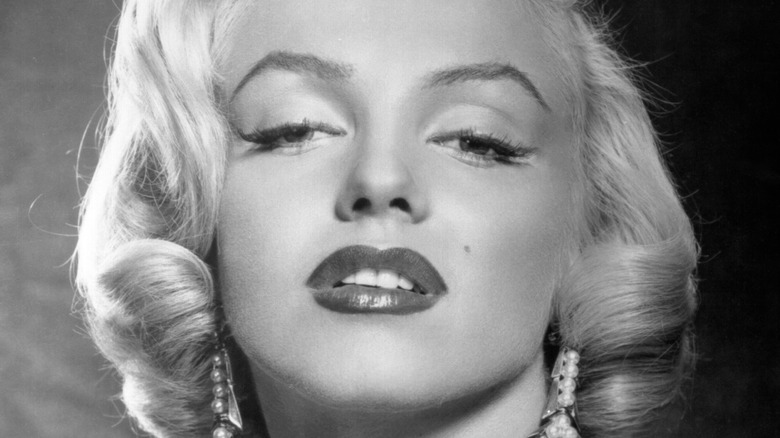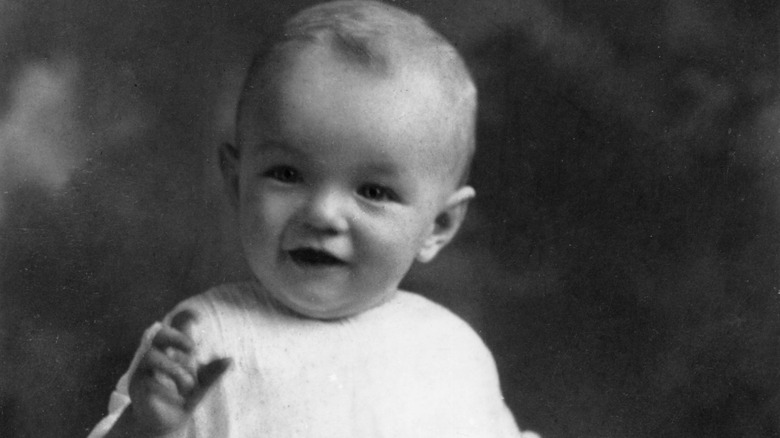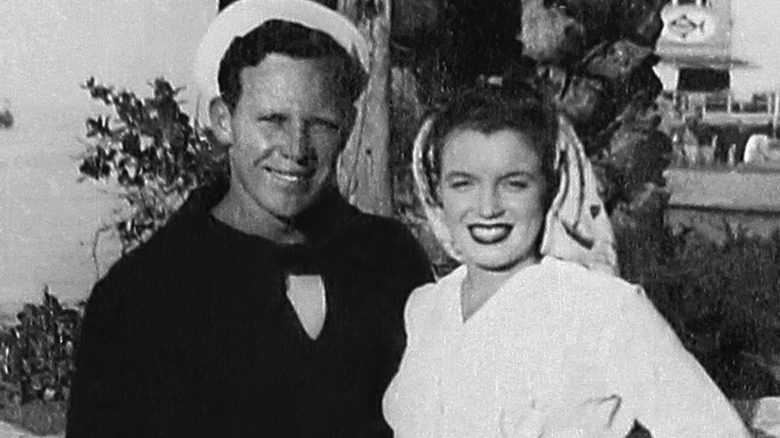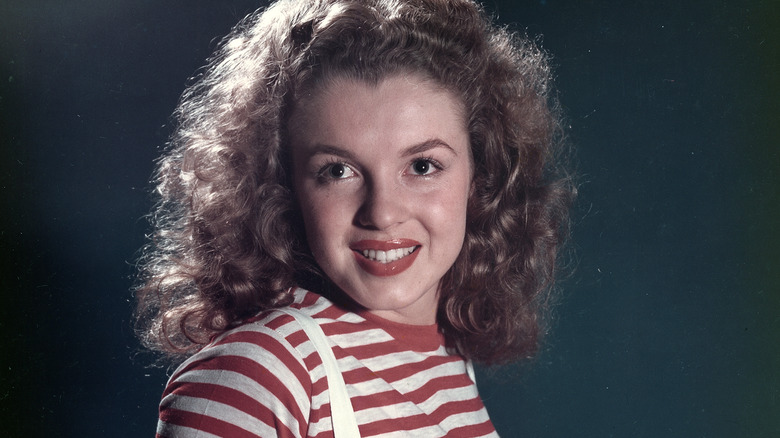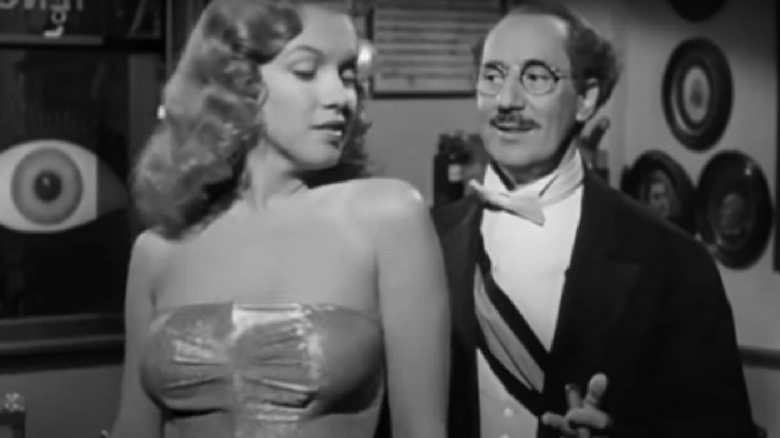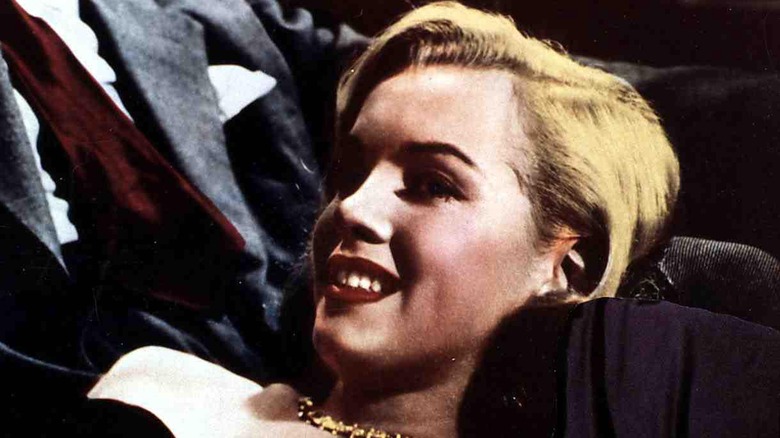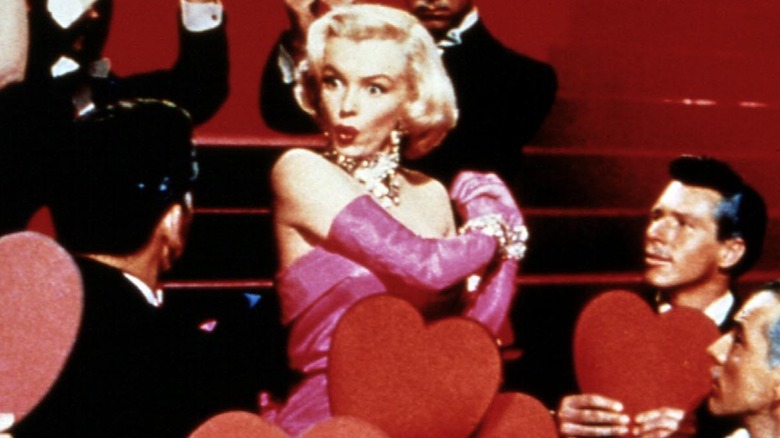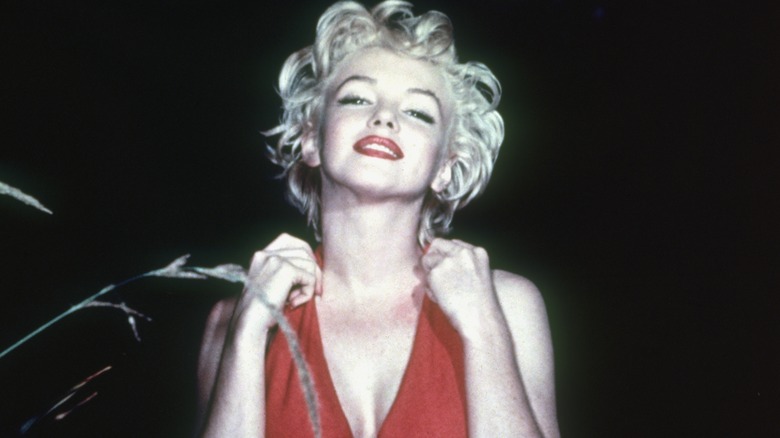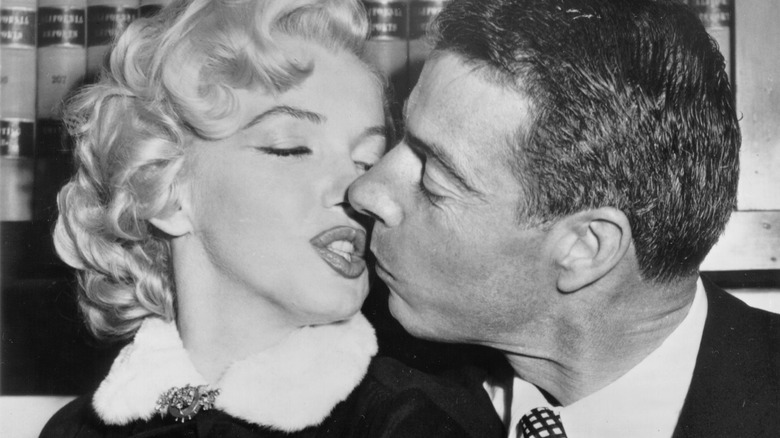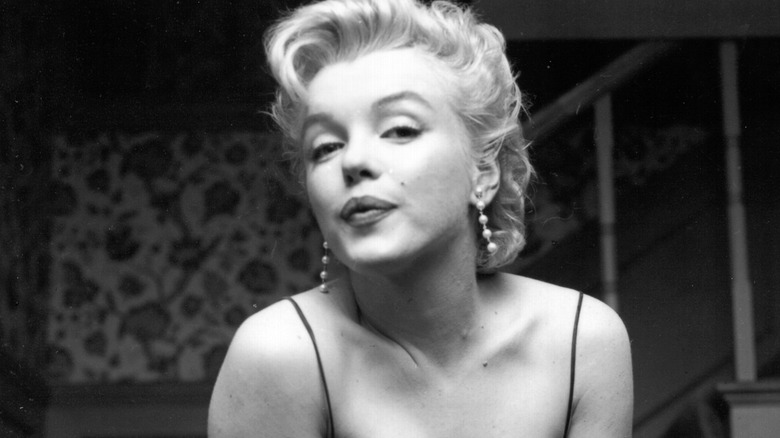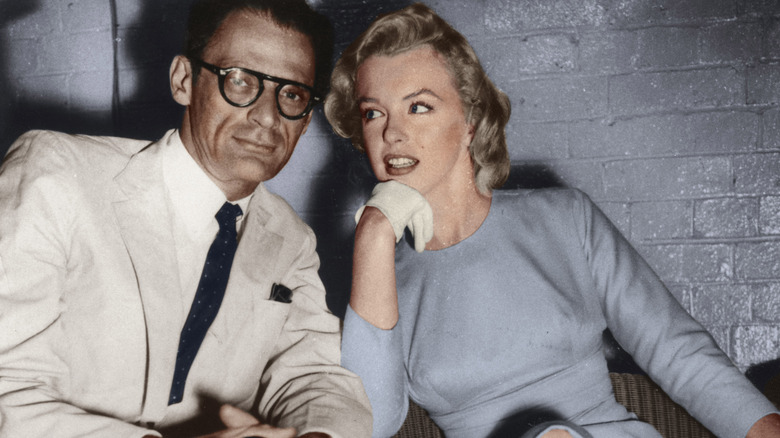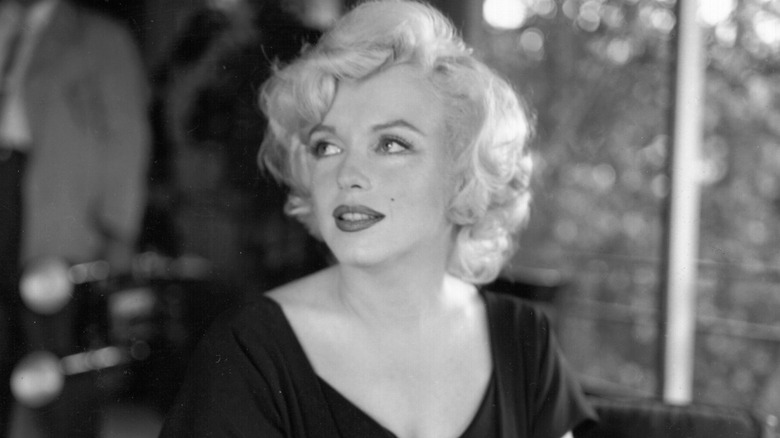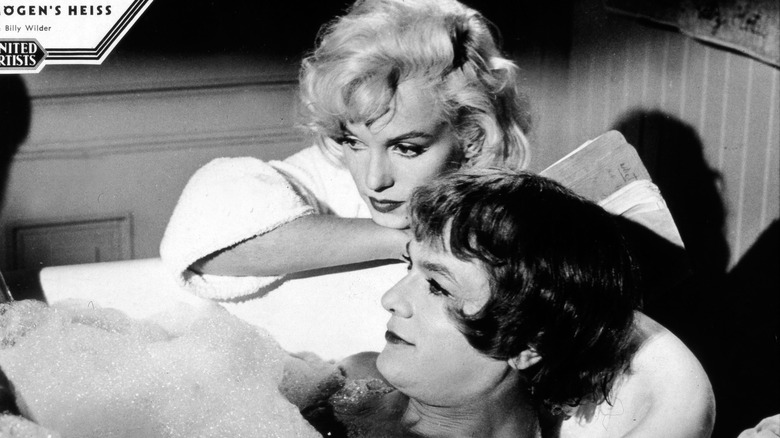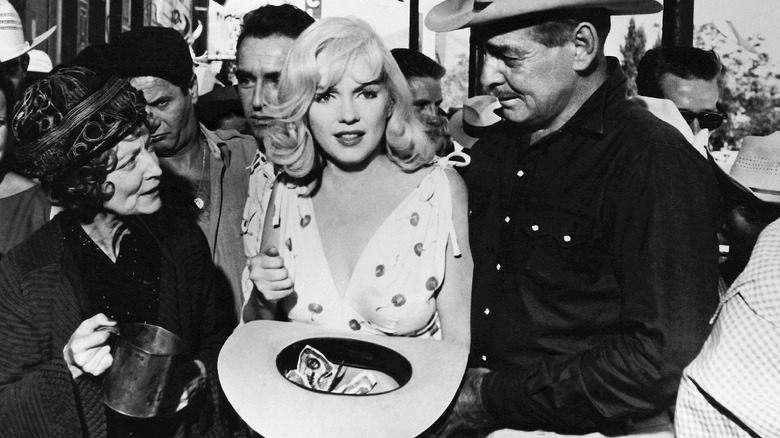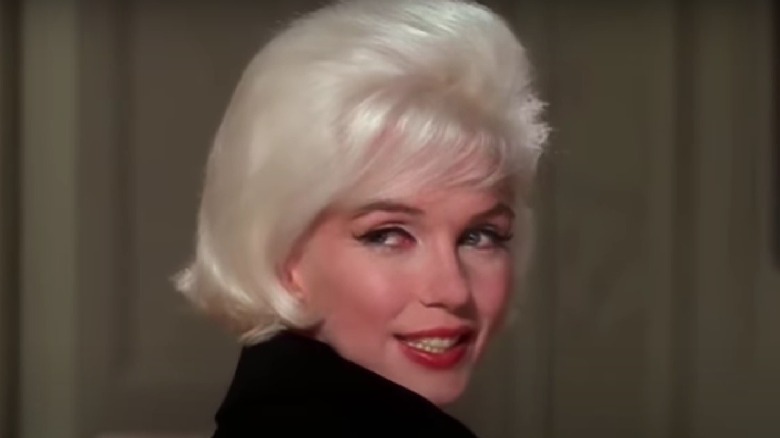The Transformation Of Marilyn Monroe From Childhood To 36 Years Old
The following article contains references to child abuse, mental illness, domestic abuse, and addiction
When it comes to icons, Marilyn Monroe is one of a kind. Arguably the most famous actor of all time, her image has been imitated incessantly, but remains unmatched. Born the same year as Queen Elizabeth II, there's a poignancy to the fact that the monarch died shortly before the release of Netflix's "Blonde" biopic. Given the chance, away from the turmoil she endured, Monroe may have lived as long as the Queen.
According to a fictional supposition of what Monroe's life would have been like if she'd lived, the actor would likely have gone on to defiantly counter her bombshell image by becoming an activist, per HuffPost. Indeed, Monroe may have been constantly reduced to her platinum blond locks and enviable curves, but she was so much more than a sex symbol. A progressive, she fought against the Hollywood blacklist, supported civil rights, and was bold in the face of discrimination from movie moguls. "I never quite understood it, this sex symbol," she once said, per The Guardian. "I always thought symbols were those things you clash together! That's the trouble, a sex symbol becomes a thing. I just hate to be a thing."
In her all too brief lifetime, Monroe was in no shortage of iconic looks, from her hot pink ensemble in "Gentlemen Prefer Blondes" to her billowing white dress in "The Seven Year Itch." As critics analyze Ana De Armas' transformation into Monroe, let's take a look at the sophisticated superstar's own transformation, from childhood to 36 years old.
Marilyn Monroe had a traumatic childhood
The movie star that people would come to know and love was born Norma Jeane Mortenson on June 1, 1926, in Los Angeles. In baby photos, the cherubic youngster looked happy and carefree, already gazing charismatically at the camera as she would throughout her career. As noted in the book "They Knew Marilyn Monroe," Monroe was given the surname of her mother's ex-husband, Jake Baker, whom she had never met, shortly after birth.
Her mom, Gladys, who died in 1984, suffered from mental health issues and was frequently admitted to psychiatric hospitals for schizophrenia, per Vanity Fair. Meanwhile, Monroe never met her father.
Ever the daydreamer, she believed that her dad may have been Clark Gable, which explains why she came to idolize the actor. As she recalls in her memoir, "My Story," her mom once showed her a photo of a man who may have been her dad. "He had a thin mustache like Clark Gable," Monroe recalled. "I felt very warm toward the picture... I asked my mother what his name was. She wouldn't answer." Gladys told her daughter that the man was killed in a car accident, but Monroe didn't believe her. Poignantly, she used to fantasize about having a father figure in her life, imagining that he would pick her up from school on rainy days and tell her how proud he was to call Norma Jeane his daughter. Through DNA testing, her dad was later confirmed to be Charles Stanley Gifford, per Variety.
If you or someone you know needs help with mental health, please contact the Crisis Text Line by texting HOME to 741741, call the National Alliance on Mental Illness helpline at 1-800-950-NAMI (6264), or visit the National Institute of Mental Health website.
She got married at 16 to avoid staying in an orphanage
Unable to cope with the pressures of being a single mom, Gladys placed the erstwhile Norma Jeane into foster care when she was barely two weeks old, per "They Knew Marilyn Monroe." Mom and daughter were reunited in 1933, when Monroe was seven, and the pair enjoyed going to the movie theater together (Gladys herself worked as a film cutter).
But soon enough, things took another unfortunate turn. Suffering from schizophrenia, Gladys struggled to care for her daughter and Monroe was essentially made an orphan, placed in various foster homes amid her stay at an orphanage. In care, Monroe was subjected to sexual abuse on a number of occasions, starting when she was just eight, per The New York Post.
Per Vanity Fair, she saw marriage as a way out of the orphanage and, in a desperate attempt to escape her bleak situation, wed James Dougherty, 21, when she was a near unrecognizable 16-year-old brunette. Dougherty viewed himself as a savior who rescued Monroe from her hopeless situation, while she saw her husband as a safe person unlike the predatory men she had previously encountered (it's been suggested that Monroe's foster father, Doc, molested her). "I was greatly attracted to him as one of the few young men I had no sexual repulsion for besides which it gave me a false sense of security to feel that he was endowed with more overwhelming qualities which I did not possess," she wrote in her diary.
If you or someone you know may be the victim of child abuse, please contact the Childhelp National Child Abuse Hotline at 1-800-4-A-Child (1-800-422-4453) or contact their live chat services.
Marilyn Monroe started out as a model
In 1945, a 19-year-old Marilyn Monroe was discovered by photographer David Conover when she was working at a munition factory, as he revealed in his journals (via Immortal Marilyn). Immediately awestruck by her charm and beauty, Conover asked Monroe if she would like to pose for some photographs for him. "Norma Jeane wants to be a movie star ... I told her she would have to be a model first," Conover wrote. In her modeling snaps, she appeared a far cry from the soon-to-be iconic Hollywood bombshell, sporting her natural reddish curls and a waifish quality.
According to the book "Before Marilyn," Monroe enrolled in a $100 course that taught her how to pose and conduct herself in the modeling industry. But her walk caused problems: she had a tendency to wiggle. Although this wiggle would go on to define her (later dubbed "jello on springs" in "Some Like It Hot"), it was not in line with the etiquette of the 1940s.
By the age of 20, Monroe was divorced and renting one room in Los Angeles, per "Goddess." She appeared on the cover of Laff Magazine four times and attracted the attention of Howard Hughes, who saw her on the cover of one such magazine when he was recuperating in hospital. Subsequently, Hughes got his assistant to call Monroe's agent, who helped get her a contract with Twentieth Century Fox.
Marilyn Monroe's early film career
Fantasy was always Marilyn Monroe's escape from the bleakness of his formative years. Subsequently, she believed acting was the perfect career for her. "When I was five I think, that's when I started wanting to be an actress," she told Life (via The Guardian). "I loved to play. I didn't like the world around me because it was kind of grim, but I loved to play house. It was like you could make your own boundaries." Her dreams were coming to fruition at Fox, where she was given her new, alliterative name.
In 1947, the 21-year-old had bit parts in the films "Dangerous Years" and "Scudda Hoo! Scudda Hay!" Her role in the latter film was initially meant to be larger, but the majority of her scenes were cut and she spoke just one line, "hello," per the book "Goddess." To better herself as an actor, she enrolled at drama school. "She came to classes on time and did all her assignments conscientiously, but I never would have predicted she would be a success," one of her acting teachers remarked.
Two years later, she appeared in the Marx Brothers' last film, "Love Happy." In a tiny but memorable role, Monroe had her hair styled in soft blond curls and wore a figure-hugging dress, as she flirted with an aging albeit characteristically witty Groucho Marx. Although looking every inch the budding bombshell, Monroe had a certain naïveté to her in these early roles, appearing almost childlike in her innocence.
Her first major role was in The Asphalt Jungle
Desperate for money, Marilyn Monroe posed nude in 1949, per Vanity Fair. When she predictably faced backlash for the snaps, a defiant Monroe replied, "I was hungry." The following year, she scored her first major film role with "The Asphalt Jungle," directed by the esteemed John Huston (father of Anjelica Huston). Monroe played the mistress of Louis Calhern's devious character, a somber role that saw the up-and-coming star looking low-key sans her famous flaxen curls. Discussing his first encounter with Monroe in a later interview (via Marilyn Monroe Archives), Huston recalled, "She ... read beautifully ... I said yes by all means." He declared that Monroe's interpretation of the character went beyond his expectations. "Good as she was, I had no idea that she would ever attain the figure, the image for a whole country, a whole world, yet eventually he did," he added.
According to the book "Goddess," Monroe began a publicized affair with Johnny Hyde in 1951 and also became roommates with fellow actor Shelley Winters, who immediately observed Monroe's childlike vulnerability. Winters noted that when she went to the bathroom, "she'd think you'd disappeared and she'd been left alone. She'd open up the door to see if you were still there. She was a little child."
Soon, Monroe exhibited her aptitude for comedic timing in 1952's "Monkey Business," starring alongside Cary Grant. The part would be a precursor to the role that soon defined her — that of the ditzy blond.
The actor soon made her mark on Hollywood
In 1953, Marilyn Monroe took on two distinct film roles which certified her versatility as a performer. The first was in the Hitchcockian "Niagara," which saw her adopting a serious (albeit still sexualized) part as an adulterous woman married to an older man. Then, she scored the role that would become one of her most iconic, in "Gentlemen Prefer Blondes." Starring as a showgirl alongside fellow bombshell Jane Russell, the camp classic cemented Monroe's status as a queer icon. The image of the starlet performing "Diamonds Are A Girl's Best Friend" in her fuchsia gown remains legendary to this day, and one of the most defining Monroe looks.
While Russell was paid a princely $200,000, Monroe was given $500 a week, which she deemed unfair considering that she embodied the titular blonde of the film. "I couldn't get a dressing room ... Still they always kept saying, 'Remember, you're not a star.' I said, 'Well, whatever I am, I am the blonde!'" she revealed to Life (via The Guardian).
Away from the cameras, Monroe and Russell got along, but shared differing sensibilities. A conservative Christian, Russell wanted to introduce her secular co-star to religion. "Jane tried to convert me and I tried to introduce her to Freud!" Monroe once remarked, per The Sunday Post. Famously, the two actors put their hands in the wet cement at Grauman's Chinese Theater, thereby fulfilling Monroe's girlhood fantasy. "Anything's possible, almost," she later reflected to Life.
Marilyn Monroe was a friend to the marginalized
By the mid '50s, Marilyn Monroe had reached sex symbol status. In a smoldering photoshoot that year, she wore a plunging ruby red dress and lipstick, showcasing the curves that made her famous. Despite the fame and publicity she was garnering, she was ultimately feeling rather lonely.
In her Life Magazine interview (via The Guardian), Monroe admitted that she didn't have many friends in the biz, having been betrayed by those she thought she trusted, only for them to sell stories about her to newspapers. But one person who was a true friend to Monroe was Ella Fitzgerald. The pals met in 1954 and hit it off immediately. As Monroe once said (via Biography), "Well, my very favorite person, and I love her as a person as well as a singer, I think she's the greatest, and that's Ella Fitzgerald." Soon enough, Monroe was helping her buddy out.
According to Monroe's acquaintance Amy Greene, who discussed the alliance between the starlet and singing sensation in the doc "Reframed: Marilyn Monroe" (via Yahoo! News), Fitzgerald wanted to sing at the restaurant Mocambo, but the venue would not allow Black singers to perform unless they were conventionally attractive. But Monroe was having none of it and got the venue to hire Fitzgerald. The show sold out. "After that, I never had to play a small jazz club again," Fitzgerald said, per Reader's Digest. "She was an unusual woman — a little ahead of her times. And she didn't know it."
Joe DiMaggio allegedly mistreated Marilyn Monroe
Marilyn Monroe's second marriage was to baseball legend Joe DiMaggio. The pair wed in 1954 and had a complex, at times tumultuous relationship. DiMaggio was reportedly prone to outbursts of jealousy, culminating in his aversion to Monroe's most iconic look, per History. In 1955's "The Seven Year Itch," Monroe famously wore a white dress that billowed in the breeze. DiMaggio was on set and grew furious when he saw the crowd of onlookers cheering for his wife.
Per The New York Post, DiMaggio wanted Monroe to be a dutiful housewife, but she was unwilling to give up acting. Subsequently, he sought to change the course of her career, demanding that he approve all her film roles before she took them on. When Monroe didn't do as she was told, DiMaggio would reportedly hit her. It was during this period that Monroe began self-medicating to treat her anxiety.
The couple split after less than a year. During divorce proceedings, Monroe accused her ex of cruelty. "My husband would get in moods where he wouldn't speak to me for five to seven days at a time — sometimes longer, ten days," she explained in court, per "Joe DiMaggio: The Hero's Life." "I would ask him what was wrong ... He would say, 'Stop nagging me!'" She also accused DiMaggio of isolating her from her friends. Despite their acrimonious split, Monroe remained DiMaggio's greatest love. As he lay dying in 1999, his last words were "I'll finally get to see Marilyn again."
If you or someone you know is dealing with domestic abuse, you can call the National Domestic Violence Hotline at 1−800−799−7233. You can also find more information, resources, and support at their website.
Marilyn Monroe was miserable at Twentieth Century Fox
By 1956, Marilyn Monroe had reached peak pinup, wearing slinky strapless dresses, which were rather risqué for the time, and perfecting the famous Monroe pose. Although she seemed to be embracing her sex symbol persona, Monroe was far from happy, sick of being exploited and reduced to the sum of her parts. "It's nice to be included in people's fantasies but you also like to be accepted for your own sake," she told Life (via The Guardian). "I don't look at myself as a commodity, but I'm sure a lot of people have. Including, well, one corporation in particular, which shall be nameless. If I'm sounding picked on or something, I think I am."
The previous year, she'd butted heads with execs at Twentieth Century Fox, where she was horribly mistreated. Studio head Darryl Zanuck made no secret of the fact that he hated Monroe, per The New York Times. Subsequently, he harassed the star, deliberately humiliating her by casting her in airhead roles that she loathed, per Marie Claire. As she once said, "An actress isn't a machine."
But the strong-willed actor refused to appease Zanuck and broke her contract with the studio. Warned that she would never work in Hollywood again, Monroe simply shrugged her shoulders and headed to New York where she mingled with intellectuals, such as Truman Capote. Finally, Fox listened to Monroe and, in a groundbreaking move, she was awarded creative control of her projects.
Her marriage to Arthur Miller caused a media stir
Despite her ditzy persona, Marilyn Monroe was an intellectual. She loved literature and owned over 400 books, per Open Culture. As such, she gravitated towards intelligent men (her pal Shelley Winters told The Los Angeles Times that Monroe's biggest crush was Albert Einstein). In 1956, she married her third and final husband, esteemed playwright Arthur Miller. The following year, the fetching couple appeared in public together, with Monroe donning a chic and sophisticated blue ensemble. "This is the first time I've been really in love," Monroe said of her new beau, per Biography.
Monroe and Miller, who first met in the early '50s, wed at the height of McCarthyism, whereby innumerable actors, writers, and directors were blacklisted from Hollywood due to their alleged ties to the Communist Party. Per "Marilyn Forever," Miller was called to testify before the House Un-American Activities, but he refused to name names. All the while, Monroe supported her husband, a gutsy move considering that doing so could have seen her being blacklisted from the industry. Subsequently, Monroe was being tracked by the FBI, with the organization keeping a file on the superstar.
According to left-wing activist Frederick Vanderbilt Field, Monroe shared Miller's leftist views. "She told us about her strong feelings for civil rights, for black equality ... her anger at red-baiting and McCarthyism and her hatred of [FBI director] J. Edgar Hoover," Field wrote in his autobiography (via CBS News).
The actor began struggling with being on camera
When she first got a major part in a movie, back in 1950 film noir "The Asphalt Jungle," John Huston was impressed by Marilyn Monroe's seamless read-through of her lines, per E! News. But as Monroe's career progressed throughout the decade, her ability to memorize her lines steadily declined. When she starred in romantic dramedy "Bus Stop" in 1956, her instability became resoundingly clear to those around her.
As her co-star Don Murray recalled in an interview with the Los Angeles Times, Monroe was often late for work and forgot her lines. "She was a very experienced film actress, but she could forget so many of the mechanical techniques," he mused. "She would constantly miss her marks so she would be out of focus or out of the light or in a shadow. I think it was a lack of confidence ... she was still terrified of going before the camera and broke out in a rash all over her body."
The following year, she faced similar difficulties whilst filming Laurence Olivier's "The Prince and the Showgirl," but her woes reached breaking point when she suffered a miscarriage while married to Arthur Miller, per "Marilyn Monroe Biography." Deeply depressed, Monroe, who had always longed to be a mom, shielded herself from the public eye until early 1958. When the star did emerge from isolation, she had a haunted look about her; although as beautiful as ever in a chic LBD and white gloves ensemble, Monroe's unhappiness was evident.
Marilyn Monroe allegedly had an affair with Tony Curtis
In 1959, Marilyn Monroe once again teamed up with Billy Wilder, who previously directed her in "The Seven Year Itch," for the hit comedy "Some Like It Hot." The film saw a sultry Monroe adopt a softer look, her hair slightly less brassy than her famous peroxide 'do and her face seemingly bathed in an angelic glow.
During filming, she had a fraught relationship with co-star Tony Curtis. Although Curtis has long claimed that he and Monroe embarked on a heated affair, he was also quick to criticize the superstar for her supposed unprofessional conduct on set. Speaking with Entertainment Weekly, he lamented Monroe's tardiness and increased reliance on alcohol. "There was nothing laid back or amusing about Marilyn on that movie," he recalled. "She was drinking a lot on the set. I know she was drinking champagne out of coffee mugs." Although Curtis has long been quoted as saying kissing Monroe was like kissing Adolf Hitler, this is apparently an urban legend. Adamant that he never uttered the remark, Curtis explained that he'd actually said kissing Monroe was like making love to her (though he didn't quite word it that way).
In his memoir (via The Guardian), Curtis purported that he impregnated Monroe on set and the lovers broke the news to Arthur Miller (Monroe was indeed pregnant when filming, but she is believed to have been carrying Miller's child). However, as SFGate highlights, Curtis' claims are dubious and entirely unsubstantiated.
Marilyn Monroe's final on screen appearance was her most haunting
In 1961, Marilyn Monroe made her final on screen appearance in "The Misfits," written by her then-husband Arthur Miller and directed by John Huston. The film saw Monroe transform both her appearance and what was expected from her as an actor. Her signature curls were replaced by sleeker, longer tresses, complete with sideswept bangs, and she famously donned a white cherry print dress.
Monroe portrayed Roslyn, a sensitive divorcee who falls for an older man. In one of the film's most distressing scenes, she vociferously opposes the way her rodeo pals, played by Clark Gable, who died soon after filming, and Montgomery Clift, treat animals, per The Independent. "The Misfits" ultimately served as a showcase of what Monroe could have achieved as an actor had she lived, as opposed to being confined to ditzy roles.
During filming, Miller found himself falling for photographer Inge Morath, per Vanity Fair. Subsequently, he split from Monroe and went on to marry Morath. Thereafter, Monroe began her descent into a downward spiral, having been locked in a psychiatric hospital without her consent. Monroe, who had simply sought help for insomnia, begged guards to release her; they refused, believing that her cries for help proved she was psychotic. "I felt I was in some kind of prison for a crime I hadn't committed," she wrote in a letter. "The inhumanity there I found archaic." Eventually, her ex, Joe DiMaggio, rescued her from the harrowing ordeal.
If you or someone you know needs help with mental health, please contact the Crisis Text Line by texting HOME to 741741, call the National Alliance on Mental Illness helpline at 1-800-950-NAMI (6264), or visit the National Institute of Mental Health website.
The tragic death of Marilyn Monroe
In 1962, Marilyn Monroe was fired from the never-completed film "Something's Got to Give" due to her unpredictable behavior, per The Independent. Suffering from ill health, she was plagued with sinusitis, a chronic virus, and had a fever. In the few scenes she filmed, Monroe looked haunted and frail. Although her charm shone through, she seemed a shadow of her former self.
In her final moments alive, Monroe simply wanted to be loved. Disinterested in material goods, the Brentwood house in which she died was purchased just months prior, and was the first she'd ever bought on her own, per Forbes. Warren Beatty was one of the last people to see Monroe alive. Having been introduced by mutual friend Peter Lawford, the pair went for a walk on the beach on August 3rd, per Vanity Fair. "It was more soulful than romantic," Beatty recalled. Also that day, Monroe called her friend Anne Karger and revealed that she was deeply in love with Bobby Kennedy, per Vanity Fair.
The following afternoon, her psychiatrist, Ralph Greenson, visited the house to check up on her, noting that she appeared depressed. That night, Monroe died of a barbiturate overdose, aged 36. Although there have been many conspiracies regarding the starlet's demise, including claims that she was murdered, her death was eventually ruled a possible suicide or accidental overdose, per The New York Times. Monroe may have sung "we all lose our charms in the end," but she remains a star that will never cease to shine.
If you or anyone you know needs help with addiction issues, help is available. Visit the Substance Abuse and Mental Health Services Administration website or contact SAMHSA's National Helpline at 1-800-662-HELP (4357).

